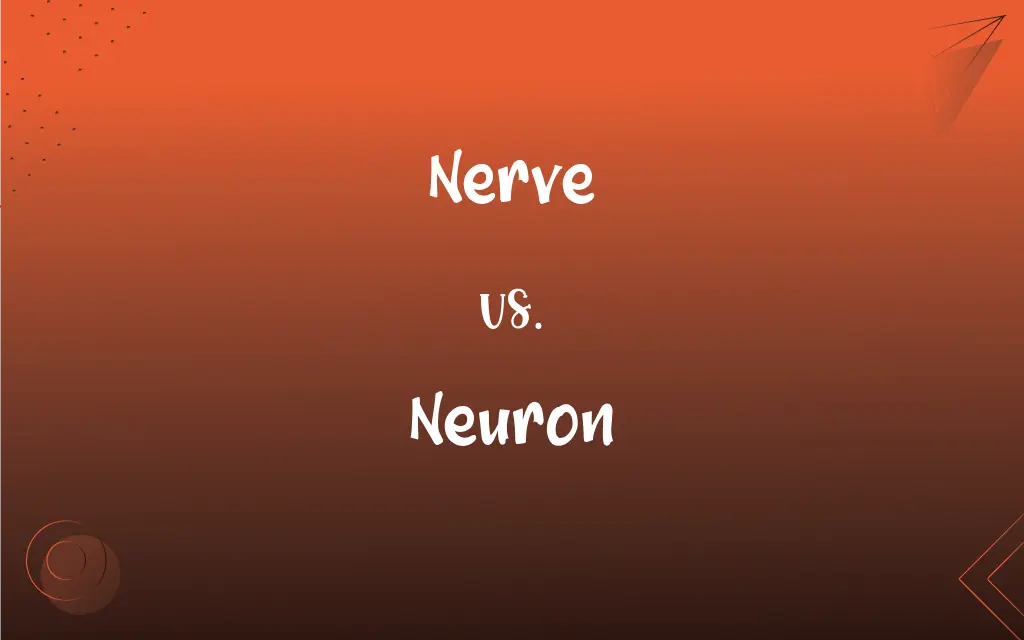Nerve vs. Neuron: What's the Difference?
Edited by Aimie Carlson || By Harlon Moss || Updated on October 28, 2023
Nerve is a bundle of fibers transmitting impulses; neuron is an individual nerve cell.

Key Differences
A nerve consists of numerous fibers known as axons, which transmit impulses throughout the body. On the other hand, a neuron is an individual cell responsible for transmitting these impulses.
Nerves serve as the highways, facilitating the movement of information. Neurons, in contrast, are like the cars traveling on these highways, each carrying its own unique set of information.
A nerve is essentially a structure made up of many neurons bound together, while a neuron is an independent entity, complete with a cell body, dendrites, and an axon.
Both nerves and neurons play pivotal roles in the nervous system, with nerves ensuring the transportation of messages and neurons acting as the message bearers.
Comparison Chart
Basic Definition
A bundle of axons.
A nerve cell.
ADVERTISEMENT
Structural Components
Contains many axons.
Has a cell body, dendrites, and an axon.
Function
Transmits impulses.
Generates and transmits electrical impulses.
Presence in CNS
Not present.
Found in brain and spinal cord.
Regeneration
Limited regeneration capacity.
Typically cannot regenerate after damage.
Nerve and Neuron Definitions
Nerve
Sensitivity or feeling.
The cold water hit my nerve endings sharply.
ADVERTISEMENT
Neuron
A specialized cell transmitting nerve impulses.
A neuron communicates with other cells via synapses.
Nerve
Audacity or impudence.
She had the nerve to lie right to my face.
Neuron
A cell capable of generating electrical signals.
A neuron fires when it receives a specific input.
Nerve
A source of sensitivity or irritation.
That topic is a nerve for him; better not bring it up.
Neuron
A conductor of information in the body.
The neuron relayed the signal from the brain to the muscles.
Nerve
A bundle of fibers that transmits impulses.
The sciatic nerve runs down the leg.
Neuron
An individual nerve cell.
Each neuron has a unique function in processing information.
Nerve
Courage or boldness.
He had the nerve to confront the thief.
Neuron
The basic unit of the nervous system.
The human brain contains billions of neurons.
Neuron
Any of the impulse-conducting cells that constitute the brain, spinal column, and nerves in vertebrates, consisting of a nucleated cell body with one or more dendrites and a single axon.
FAQs
What is a nerve in simple terms?
A nerve is a bundle of axons that transmit impulses.
Do neurons regenerate?
Typically, neurons cannot regenerate after damage.
Can a nerve regenerate?
Nerves have limited regeneration capacity, but it's not guaranteed.
Where are nerves found?
Nerves are found throughout the body, connecting organs and muscles to the brain and spinal cord.
Are all nerves sensitive?
Nerves contain fibers responsible for different sensations, so not all nerves respond to the same stimuli.
How many neurons are in the human brain?
The human brain contains approximately 86 billion neurons.
What protects our nerves and neurons?
Nerves are often protected by a myelin sheath, and neurons are protected by the blood-brain barrier and other mechanisms.
Is a neuron the same as a nerve?
No, a neuron is an individual nerve cell, while a nerve is a bundle of these cells.
Are there different types of nerves?
Yes, there are sensory nerves, motor nerves, and autonomic nerves, each with specific functions.
Why are nerves important?
Nerves are crucial for transmitting information between the brain and the rest of the body.
What is a neuron's lifespan?
Many neurons last a lifetime, but they can be damaged or die due to various factors.
Where are neurons located?
Neurons are found in the brain, spinal cord, and peripheral nervous system.
Can you see a nerve with the naked eye?
Some nerves, like the sciatic nerve, are thick enough to be visible to the naked eye.
How do nerves get damaged?
Nerves can be damaged by physical injury, diseases, toxins, and other factors.
What happens when a neuron dies?
When a neuron dies, its function is lost, and depending on its location, this can impact various bodily functions.
How do nerves and neurons work together?
Neurons generate impulses, and nerves act as highways to transmit these impulses throughout the body.
Can you feel a nerve?
Nerves themselves aren't felt, but they transmit sensations like pain, temperature, and touch.
How do neurons communicate?
Neurons communicate through electrical impulses and neurotransmitters at synapses.
How small is a neuron?
Neurons vary in size, but many are microscopic and require magnification to be seen.
What's the function of a neuron?
A neuron's primary function is to generate and transmit electrical impulses.
About Author
Written by
Harlon MossHarlon is a seasoned quality moderator and accomplished content writer for Difference Wiki. An alumnus of the prestigious University of California, he earned his degree in Computer Science. Leveraging his academic background, Harlon brings a meticulous and informed perspective to his work, ensuring content accuracy and excellence.
Edited by
Aimie CarlsonAimie Carlson, holding a master's degree in English literature, is a fervent English language enthusiast. She lends her writing talents to Difference Wiki, a prominent website that specializes in comparisons, offering readers insightful analyses that both captivate and inform.































































